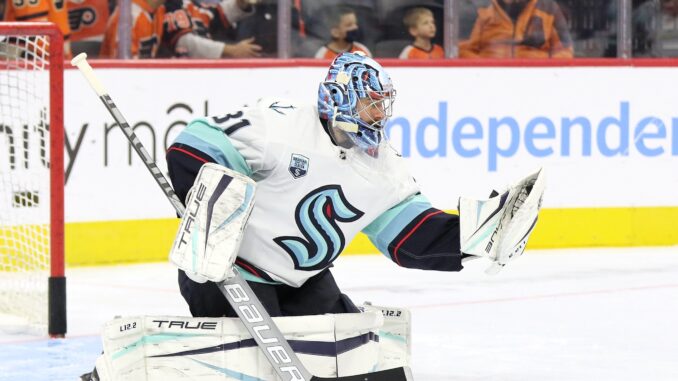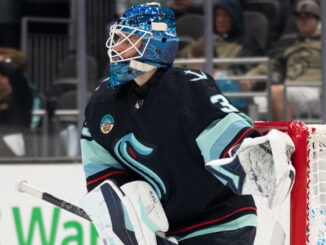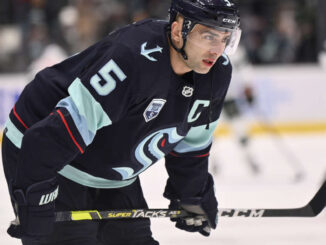
Heading into the Seattle Kraken’s inaugural season, much was made of their formidable goaltending tandem, which stood to cement Seattle’s defensive identity. The sturdy pairing consisting of Philipp Grubauer (a Vezina Trophy finalist last season) and Chris Driedger (a career-journeyman playing out of his mind in relief of the ailing Sergei Bobrovsky) would act as a buffer against the Kraken’s offensive shortcomings.
Instead, the duo has seen their collective performances tank remarkably this season, with the Kraken’s .878 team save percentage (SV%) ranking dead last in the entire NHL. Their moving portrayals of fishing nets (because they’re full of holes, get it?) are among the leading contributors to why Seattle currently sits 29th out of 32 teams in the overall standings. Fortunately, Grubauer appears to have turned a corner, playing at a level more commensurate with a player carrying his sizeable cap hit ($5.8 million per year). Let’s dig in.
2022 Bringing Better Fortunes for Grubauer
In Grubauer’s most recent start against the New York Islanders (a 3-0 victory), the big German stopped all 19 shots he faced, tallying his first shutout as a member of the Kraken and the 19th of his career. His strong display on an admittedly quiet night could be the ointment used to pacify his early-season wounds and sparking his inner competitive drive in the process.
Related: 3 Seattle Kraken Coaching Candidates If Hakstol Is Fired
Since January 17th, Grubauer has made seven starts and owns a 5-2-0 record over that stretch. He’s had a single-game SV% of at least .920 in four out of those seven games and can point to a .915 mark overall over his brief run of inspired play. The 30-year-old netminder is settling into a comfortable groove, more closely resembling his career average of a .916 SV%.
Among goalies to have played in at least five games in the past two-and-a-half weeks, Grubauer ranks first in wins (five), 13th in SV%, and seventh in goals-against average (2.14 GAA). To be fair, that represents an extremely limited sample size and invites valid questions as to whether this is the true version of Grubauer and if he’ll revert to the version which opened the season before long.
Kraken Remain Elite Defensive Team
One of the most perplexing factors of Grubauer’s (and Seattle’s by extent) early struggles was that under the surface, the Kraken were – and still are – revving along as a stingy defensive unit.
Over the aforementioned seven-game sequence, the Kraken ranked highly in shots (second with 24.2/60) and scoring chances against (ninth with 26.1/60) per-60-minutes, as well as the rate at which they concede expected goals (first with 1.94/60) during five-on-five play. Those results do not deviate heavily from their full-season numbers where the Kraken sit in the top five in each respective statistical category.
Where the greatest discrepancy lies is the difference in actual goals conceded, providing a tangible boost to their performance in the standings. From the beginning of the season until January 16th, the Kraken allowed 3.17 goals against per-60, the second-worst rate in the NHL. From the 17th onward, Seattle has been on the hook for only 1.79 5v5 goals against per-60, a difference of almost a goal-and-a-half per-60.
Further, that mark is good for fifth over that time, which makes the Kraken a much tougher out when accounting for their weak offensive output (25th in goals for per-60 in all situations).
Kraken Goaltending Still Facing Uncertainty
Even with Grubauer’s improved play, the Kraken have yet to settle on a dependable backup option to support their starting goaltender. No matter who they have thrown into the crease, the team has struggled to keep the puck out of the net regularly.
Related: Seattle Kraken – Revisiting 3 Bold Preseason Predictions At Halfway Point
Both of Driedger (.895 SV% in 12 games) and Joey Daccord (.858 in four games) have failed to approach anything resembling competence in their supporting roles. Driedger’s .927 SV% from last season and career mark of .921 provide hope that he can reclaim his form in short order. Still, his relatively small big-league sample size (exactly 50 NHL games to his name) is worrying for the organization. Which is the real Driedger? Is it the one who backstopped the Florida Panthers to a playoff spot last season, or is it the one who has struggled to acclimate to Seattle’s system through the first part of the year?
Daccord provides even less reassurance than Driedger in having only played 13 total NHL games, in which he’s posted an .883 SV% and a 3.70 GAA. The 25-year-old’s American Hockey League (AHL) numbers are stronger (.918 SV% in 18 games), so he could step up in a pinch, but that’s not a recipe for long-term success. It looks like it’ll be Grubauer or bust for the time being, so he needs to maintain his recent run of form if the Kraken are to rebound from their atrocious start to the campaign.
Can Grubauer and the Kraken Finish 2021-22 Strong?
While it’s difficult to parse whether Grubauer’s slight resurgence is due to the Kraken’s impervious defensive scheme, the swinging pendulum of the law of averages, or becoming more accustomed to a new locale, whatever he’s doing is working at the moment. Although the 2021-22 season appears to be a lost cause at this point (the Kraken sit 18 points back of the Calgary Flames for the final Western Conference wildcard spot), their competitive pride remains on the line. Can Grubauer finish the season strong and carry that momentum into next year?




